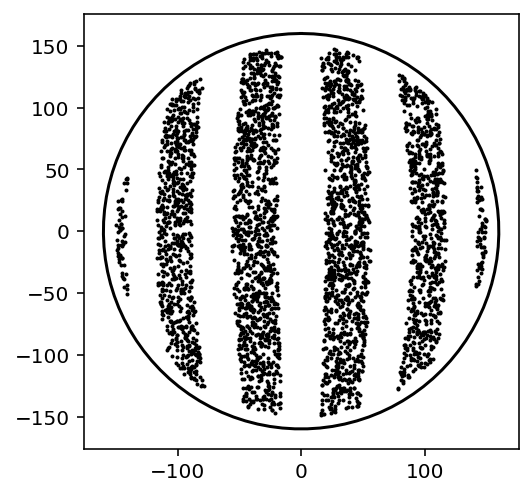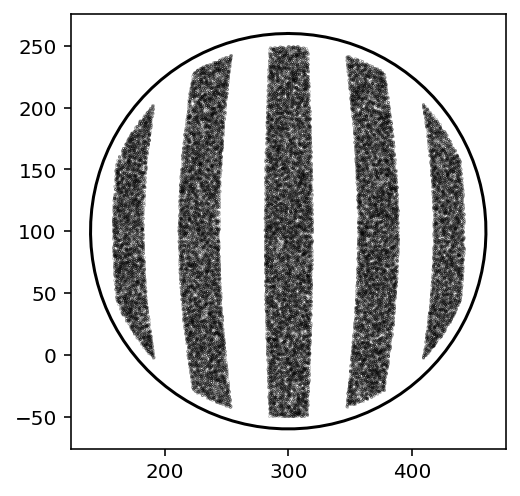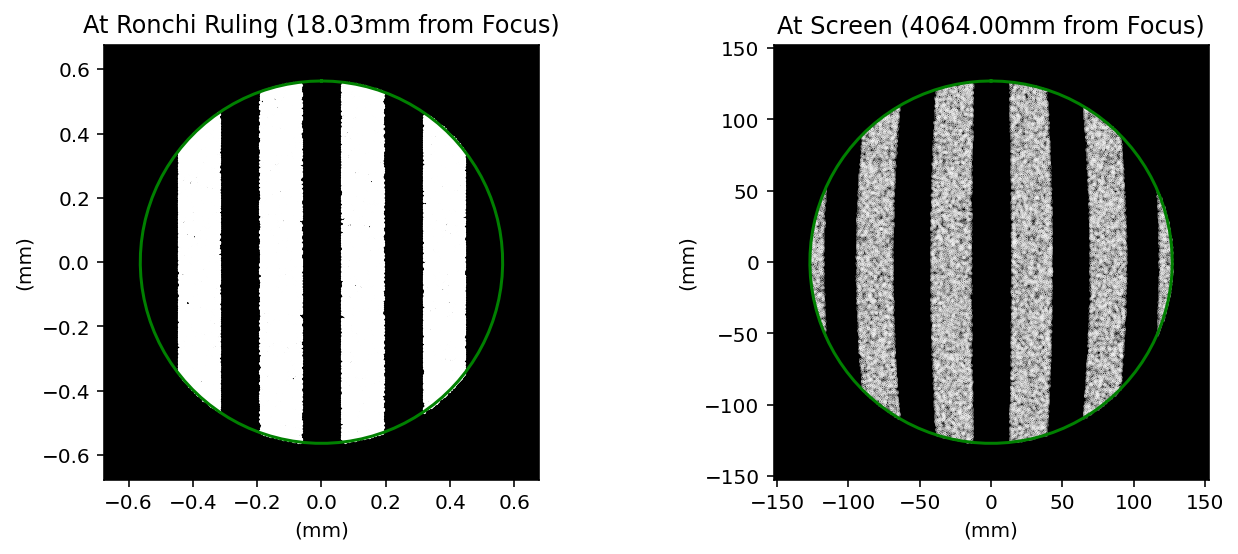Ronchigram ported from BASIC
Scott Prahl
April 2021
This notebook is only of historical interest but might be of help to someone trying to write their first ronchigram program.
From the April 1991 issue of Sky and Telescope, page 419, has code written in BASIC that creates a ronchigram for a parabolic mirror.
https://skyandtelescope.org/astronomy-resources/basic-programs-from-sky-telescope/
[1]:
import time
import numpy as np
import matplotlib.pyplot as plt
import lenstest
%config InlineBackend.figure_format='retina'
Original Source
Here is a listing of the original basic program. It is only 51 lines long and was pretty easy to port to python.
10 REM RONCHI.BAS
20 REM
30 INPUT "Mirror diameter ";D
40 INPUT "Radius of curvature";R
50 INPUT "Grating frequency ";F
60 PRINT "Grating distance Delta"
70 PRINT " from the mirror's
80 PRINT " center of curvature"
90 INPUT " (+ is outside) ";DL
100 W=1/(2*F): REM Line width
120 CLS
130 SCREEN 2
140 X0=300: Y0=100: C=300
150 K=.42
160 CIRCLE (X0,Y0),C/2
170 FOR I=1 TO 10000
180 X=D*(RND(1)-.5)
190 Y=D*(RND(1)-.5)
200 REM X and Y are the ray's
210 REM coordinates on the face
220 REM of the mirror
230 S2=X*X+Y*Y
240 IF SQR(S2)>D/2 THEN 390
250 Z=R+S2/R
260 L=R+DL-Z
270 U=L*X/Z
280 REM Now, test to see if the
290 REM ray is blocked (FL=0)
300 REM or transmitted (FL=1)
310 REM by the grating
320 FL=0: REM Reset flag
330 T=INT(ABS(U/W)+.5)
340 IF T/2=INT(T/2) THEN FL=1
350 IF FL=0 THEN 390
360 XP=X0+X*C/D
370 YP=Y0+Y*K*C/D
380 PSET(XP,YP): REM Plot point
390 NEXT I
400 LOCATE 1,1
410 PRINT "Diameter = ";D
420 LOCATE 2,1
430 PRINT "R of C = ";R
440 LOCATE 3,1
450 PRINT "Ronchi freq =";F
460 LOCATE 4,1
470 PRINT "Delta = ";DL
480 END
490 REM ************************************
500 REM APPEARED IN ASTRONOMICAL COMPUTING
510 REM SKY & TELESCOPE - APRIL 1991 ISSUE
520 REM ************************************
First translation of the BASIC program
This version is slow.
[2]:
start = time.time()
Fnumber = 4
D = 10 # inches mirror diameter
F = 100 # lines per inch (grating frequency)
DL = -0.62 # Grating to mirrors center
R = 160 # inches
W=1/(2*F) # lines per inch
X0=0
Y0=0
C=300
K=0.42
Rsqr = (D/2)**2
K=1
print(" Diameter %6.2f in" % D)
print("Radius of Curvature %6.2f in" % R)
print(" Delta %6.2f in" % DL)
print(" Focal Length %6.2f in" % (R/2))
print(" F# %6.2f" % (R/2/D))
print(" Ronchi freq %6.2f lines per in" % F)
print()
lenstest.lenstest.draw_circle(R,X0,Y0)
for i in range(10000):
# X,Y are coordinates on the face of the mirror
X=D*(np.random.random()-0.5)
Y=D*(np.random.random()-0.5)
S2=X*X+Y*Y
if S2 <= Rsqr:
Z=R+S2/R
L=R+DL-Z
U=L*X/Z
# Now, test to see if the ray is blocked (FL=0) or transmitted (FL=1) by the grating
T=int(abs(U/W)+.5)
if T % 2 > 0:
XP=X0+X*C/D
YP=Y0+Y*K*C/D
plt.plot([XP],[YP],'o', markersize=1, color='black')
plt.gca().set_aspect('equal')
plt.show()
end = time.time()
print("elapsed time = %.0f ms" % (1000*(end - start)))
Diameter 10.00 in
Radius of Curvature 160.00 in
Delta -0.62 in
Focal Length 80.00 in
F# 8.00
Ronchi freq 100.00 lines per in

elapsed time = 3133 ms
Revised version without loops
This version is some 30X faster and does 10X more points.
[3]:
start = time.time()
Fnumber = 4
D = 10 # inches mirror diameter
F = 100 # lines per inch (grating frequency)
DL = -0.62 # Grating to mirrors center
R = 160 # inches
W=1/(2*F) # lines per inch
npoints = 100000
X0=300
Y0=100
C=300
K=0.42
K=1
print(" Diameter %6.2f in" % D)
print("Radius of Curvature %6.2f in" % R)
print(" Delta %6.2f in" % DL)
print(" Focal Length %6.2f in" % (R/2))
print(" F# %6.2f" % (R/2/D))
print(" Ronchi freq %6.2f lines per in" % F)
print()
plt.subplots(1,1,figsize=(6,4))
plt.subplot(1,1,1)
lenstest.lenstest.draw_circle(R,X0,Y0)
U1 = np.random.uniform(size = npoints)
U2 = np.random.uniform(size = npoints)
X = D/2 * np.sqrt(U2) * np.cos(2 * np.pi * U1)
Y = D/2 * np.sqrt(U2) * np.sin(2 * np.pi * U1)
Z=R+(X**2+Y**2)/R
U=(R+DL)*X/Z - X
T=(np.abs(U/W)+0.5).astype(int)
Tmask = T%2==1
XP=X0+X*C/D
YP=Y0+Y*K*C/D
xp_mask = np.ma.masked_where(Tmask, XP)
yp_mask = np.ma.masked_where(Tmask, YP)
plt.plot(xp_mask,yp_mask,'o', markersize=0.1, color='black')
plt.gca().set_aspect('equal')
plt.show()
end = time.time()
print("elapsed time = %.0f ms" % (1000*(end - start)))
Diameter 10.00 in
Radius of Curvature 160.00 in
Delta -0.62 in
Focal Length 80.00 in
F# 8.00
Ronchi freq 100.00 lines per in

elapsed time = 158 ms
version in the lenstest library
[4]:
F = 100 # grating frequency in [lines/inch]
conic = 0 # spherical
D = 10 * 25.4 # mirror diameter [mm]
z_offset = 0.71*25.4 # Ronchi location relative to focus [mm}
RoC = 160 * 25.4 # mm
lp_per_mm = 100/25.4 # line pairs per mi
fig, ax = lenstest.ronchi.plot_ruling_and_screen(D, RoC, lp_per_mm, z_offset, conic)
fig.set_size_inches(11, 4)
plt.show()

[ ]: